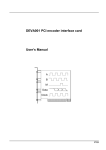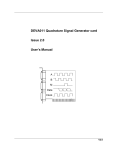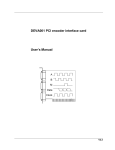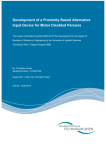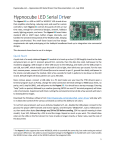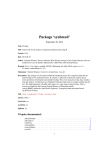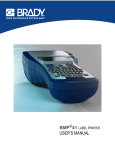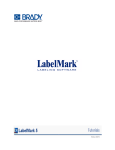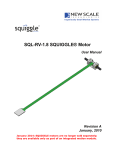Download Deva037 Manual V10 - Deva Electronic Controls Ltd
Transcript
DEVA037 USB encoder interface card with optical edge detection User’s Manual A B M P O V1.0 52 Woodside Business Park Birkenhead Wirral CH41 1EL United Kingdom Tel +44 (0)151 647 3222 Fax +44 (0)151 647 4511 Email: [email protected] Web: www.deva.co.uk All information of a technical nature and particulars of the product and its use are given by Deva Electronic Controls Ltd. in good faith. However, it is acknowledged that there may be errors and omissions in this manual. We shall not be liable for loss or damage whatsoever arising from the use of any information or particulars in, or any omissions from, this document. V1.0 DEVA001 PCI User’s Manual Overview 1 Overview ........................................................................1 1.1 Product Features..................................................................... 1 1.1.1 Features...................................................................................................... 1 1.2 Support software..................................................................... 1 1.2.1 Windows 8/7/Vista/XP 32/64 ..................................................................... 1 1.2.2 Digital Readout .......................................................................................... 2 1.3 Accessories ............................................................................. 2 2 Installation and configuration ......................................3 2.1 Software support CDROM ...................................................... 3 2.2 USB Plug and Play cards ........................................................ 3 2.2.1 System requirements ................................................................................ 3 2.2.2 Device driver installation .......................................................................... 4 3 Device Driver Usage......................................................5 3.1 Device driver functions........................................................... 5 3.1.1 System information ................................................................................... 5 3.1.2 Channel information.................................................................................. 5 3.1.3 Marker information.................................................................................... 7 3.1.4 Zero information ........................................................................................ 8 3.1.5 Extended axes ........................................................................................... 8 3.1.6 Input status ................................................................................................ 9 3.1.7 Timer information...................................................................................... 9 3.1.8 DAC Control ............................................................................................. 10 3.1.9 Output control.......................................................................................... 10 3.1.10 Probe information.................................................................................... 10 3.1.11 Probe information extended................................................................... 11 3.1.12 Time-stamper information ...................................................................... 11 3.1.13 Pulse generator information................................................................... 12 3.1.14 Axis compare information ...................................................................... 13 3.1.15 User event information ........................................................................... 13 3.1.16 Input event information........................................................................... 13 i Overview DEVA001 PCI User’s Manual 3.1.17 Digital I/O information............................................................................. 15 3.1.18 FIFO buffer information .......................................................................... 15 3.1.19 Software call-back information.............................................................. 17 3.1.20 Optical edge detector.............................................................................. 17 3.2 Function compatibility .......................................................... 19 3.3 Device driver programming from ‘C’ ................................... 22 3.3.1 3.3.2 3.3.3 3.3.4 3.3.5 3.3.6 short open_encoder (void) ..................................................................... 22 void close_encoder (void) ...................................................................... 22 long read_encoder (short command, short channel) .......................... 22 void write_encoder (short command, short channel, long value)...... 22 short enclib_callback (short receive, long priority);............................ 23 Example 'C' programming...................................................................... 24 3.4 Device driver programming from Visual Basic ................... 25 3.4.1 Function open_encoder () As Integer.................................................... 25 3.4.2 Function close_encoder () As Integer ................................................... 25 3.4.3 Function read_encoder (ByVal com As Integer, ByVal chan As Integer) As Long...................................................................................... 25 3.4.4 Function write_encoder (ByVal com As Integer, ByVal chan As Integer, ByVal value As Long) As Integer ............................................. 25 3.4.5 Example Visual Basic programming..................................................... 26 3.5 Device driver programming from C# .Net............................ 28 3.5.1 3.5.2 3.5.3 3.5.4 public static short open_encoder() ....................................................... 28 public static void close_encoder() ........................................................ 28 public static int read_encoder(short command, short channel) ........ 28 public static void write_encoder(short command, short channel, int value) ........................................................................................................ 28 3.5.5 Example C# programming ..................................................................... 29 4 USB incremental encoder interface hardware ......... 30 4.1 Functional description.......................................................... 30 4.1.1 Quadrature input ..................................................................................... 30 4.1.2 Marker input............................................................................................. 30 4.1.3 Zero input................................................................................................. 30 ii DEVA001 PCI User’s Manual Overview 4.1.4 Touch Probe Interface............................................................................. 31 4.2 Optical edge detector input. ................................................. 31 4.3 Connection details ................................................................ 32 4.3.1 4.3.2 4.3.3 4.3.4 4.3.5 Encoder input connections .................................................................... 32 Touch probe input connections ............................................................. 33 USB connection....................................................................................... 33 Internal Encoder Power .......................................................................... 34 Optical ...................................................................................................... 34 iii 1 Overview 1.1 Product Features The DEVA037 3 axis incremental encoder interface cards have been designed to enable simultaneous reading of 3 encoders using a PC based system. They can be used for a wide range of measurement applications, such as optical projectors and co-ordinate measuring machines. The range includes support for PCIe, PCI and ISA bus interfaces. All three types share many common features; however the PCI / PCIe variants have several additional facilities. 1.1.1 Features 1.2 • Three encoder inputs for differential or single - ended input • 32 bit counters for each encoder channel • Marker input (freeze / capture) for each encoder channel • +5v and +12v Power supply pass through on encoder connectors • Digital filters on all channels • Timer / Event driven interrupt logic • Touch probe input • Optical edge input Support software A variety of software drivers and libraries are provided with the interface card to enable software development to be performed within a number of operating systems and applications. Software support is an ongoing activity, if support for a particular application or operating system is not currently provided, please call the Deva office to determine its availability. 1.2.1 Windows 8/7/Vista/XP 32/64 The Deva037 is supported in Windows 8/7/Vista/XP 32/64 by a Windows driver model driver (WDM). The driver supports a standard programming interface. Please refer to section 3 ‘Device Driver Usage’ for more details. 1.2.2 Digital Readout A powerful digital readout is supplied which is capable of exercising all the common facilities of the DEVA037. This is useful to allow users to quickly verify that the DEVA037 is installed correctly and to make checks of their system without having to write their own software. The DRO will handle up to four cards (12 axes) and displays both absolute and incremental positions. The DRO also displays the Marker register, Probe register and allows control of the Probe and Footswitch options. To allow the user to read meaningful values each axis of the DRO may be independently scaled to display real units. For the incremental card all facilities such as Marker, Probe and Optical edge detect may be toggled on and off. If a Probe is activated the probed values are shown in the Probe register, if a Marker is activated the value is shown in the Marker register an if the Optical edge is activated the values are shown in the Optical register. 1.3 Accessories The DEVA037 incremental encoder interface is supplied with three high density 15 way 'D' type connectors, one 9 way ‘D’ type connector and matching shells. 2 Installation and configuration 2.1 Software support CDROM The DEVA037 3-axis encoder interface card is supplied with a software support CDROM containing support for all DEVA037 encoder interfaces along with support and information for many of Deva’s other products. The CDROM includes the following items: · Windows 8/7/Vista/XP 32/64 bit device drivers, providing coherent encoder interface card hardware management. · Windows 8/7/Vista/XP 32/64 bit DLL and import library, containing the driver access functions. · 'C' language library routines and header files, which create a simple interface to device driver functions. · Example 'C' programs, illustrating card read/write using device driver functions. · Visual Basic 6 Module, which provides constant and function definitions to allow simple DLL access. · Example Visual Basic 6 programs, illustrating card read/write using device driver functions. · .Net 2.0 Assembly, which provides a complete interface to the standard DLL. · Example C# programs, illustrating card read/write using device driver functions. · Demonstration Digital Readout Program for Windows 8/7/Vista/XP 32 and 64 bit. 2.2 USB Plug and Play cards 2.2.1 System requirements The device driver library functions and the demonstration software require a PC computer with one spare USB connector and Windows 8/7/Vista or XP 32/64 bit operating systems. Both 32 and 64 bit operating systems are fully supported. 2.2.2 Device driver installation 2.2.2.1 Windows 8 / 7 / Vista / XP installation When the card is connected windows will indicate that a new device has been found and will start the standard driver installation procedure. If this does not occur it is possible to initiate this process manually via the ‘add new hardware’ icon in the control panel or via the windows device manager. Follow the instructions and when requested select ‘have disk’ and then browse to the directory on the installation CDROM containing the Deva037.inf file. For example : \PC interface products\Deva037\Issue1.x\Drivers\ Click ok and follow instructions to complete the installation. The installation may be tested using the supplied DRO program which may be found on the CD in the utils\Win32 or utils\Win64 directories. 3 Device Driver Usage 3.1 Device driver functions The supplied Windows 8/7/Vista/XP 32/64 bit device drivers provide a simple method of accessing card functions and remove the need for direct register programming. Use of the device driver ensures that the user's application software is compatible with other Deva products and is protected from any future changes in the card hardware or register layout. The device driver determines the total number of axes and I/O available from all the cards in a system. This section describes the functions provided by the device driver whilst the compatibility chart in section 3.2 details the functions available from particular cards. 3.1.1 System information Command & equate Channel Rd/Wr Operation 0 VECTOR Not used Rd Provides a vector to the device driver command handler. 1 NUM_AXES Not used Rd Returns the total number of axis channels available from the installed cards. 2 NUM_TIMERS Not used Rd Returns the total number of timers available from the installed cards. 3 NUM_INPUTS Not used Rd Returns the total number of digital inputs available from the installed cards. 4. NUM_DACS Not used Rd Returns the total number of digital to analog converters available from the installed cards. 5. NUM_OUTPUTS Not used Rd Returns the total number of digital outputs available from the installed cards. 7. NUM_BOARDS Not used Rd Returns the number of encoder cards present in the system. 8. CARD_TYPE Not used Rd Returns the card type identifier. 9. VERSION_NUM Not used Rd Returns the device multiplied by 100. Command & equate Channel Rd/Wr Operation 10 CNT_16 Axis no. Rd/Wr Allows direct 16 bit read/write of the counter chip registers. driver version number 3.1.2 Channel information 11 MODE Axis no. Rd/Wr INC_MODE Bit 0-3 4 5 6 7 8 9 Allows access to the mode registers of the incremental encoder counter chip or the SSI mode register. Incremental mode number formed from a variety of bit fields. Function Count mode: 5=QUADx4AB, quadrature AB decode (default) 8=CNTAx2DIRB, count rising and falling edges of A, B selects count up/down direction 9=CNTADIRB, count rising edges of A, B selects count up/down direction Invert quadrature signal A Invert quadrature signal B Invert marker signal M Invert zero signal Z Disable marker synchronisation with signals A & B Count inhibit SSI_MODE Bit 0-2 (ISA) 0-2 (PCI) 3-7 8-11 12-13 14 15 16-18 18-22 23 24-29 30-31 SSI mode number formed from a variety of bit fields. Function Frequency 0=2.50Mhz, 1=1.25Mhz, 2=625kHz, 3=313kHz, 4=156kHz, 5-7=78.1kHz Frequency 0=2.78Mhz, 1=1.39Mhz, 2=694kHz, 3=347kHz, 4=174kHz, 5-7=86.8kHz Reserved Offset 0 to 15 bits Extra bit, 0=None, 1=Power fail, 2=Even Parity, 3=Odd parity 0=Binary, 1=Gray Output control, 0=Off, 1=On Acquisition mode, 0=One Shot, 1=Timer, 2-3=Continuous, 4=Channel Digital Input 0 Reserved Read Complete Interrupt Enable, 0=Off (Default), 1=On Data length 1 to 32 Reserved 12 AXIS_SIZE Axis no. Rd Returns the number of 16 bit registers allocated to an input channel. 13 ENCODER_TYPE Axis no. Rd 0 = Incremental, 1 = SSI 14 AXIS_INPUTS Axis no. Rd Returns the status of the axis (post filter & inverter) inputs. The bit fields indicate 0 or 1 depending on the state of the axis inputs. INC_INPUTS Bit 0 1 2 3 4 5 Status Quadrature input A Quadrature input B Marker input M Zero input Z Limit input 0 Limit input 1 Incremental inputs register formed from a variety of bit fields. SSI_INPUTS Bit 0 SSI inputs register formed from a variety of bit fields. Status Raw SSI data input 15 AXIS_STATUS Axis no. Rd INC_STATUS Bit 0 1 Incremental status register formed from a variety of bit fields. Status Power supply failure Quadrature error SSI_STATUS Bit 0 1 2 Returns the axis status register. The bit fields indicate 0 or 1 depending on the status bit. SSI status register formed from a variety of bit fields. Status Power supply failure Parity failure Read complete occur 16 AXIS_OUT_EN Axis no. Rd Enables the axis digital outputs. Specifying 1/0 in each bit field enables/disables the equivalent digital output. INC_OUT_EN N/A SSI_OUT_EN SSI axis digital output enable register formed from a variety of bit fields. Bit 0 1 Status SSI Read Trigger SSI Read Complete 3.1.3 Marker information Command & equate Channel Rd/Wr Operation 20 MARK_16 Axis no. Rd Returns the value of a 16-bit counter register latched by the last marker function (or any other function the marker latch source is set to). See commands 23 and 26. 21 MARK_INPUT Axis no. Rd Returns either 0 or 1 depending on the state of the marker input. 22 MARK_INT Axis no. Rd/Wr Allows access to the card interrupt controller mask. Writing a value of 1/0 enables/disables an interrupt from the marker input. This function is for special applications only. 23 MARK_FUNC Axis no. Rd/Wr Writing a value of 1/0 enables/disables the channel marker function. 24 MARK_INT_VECT Axis no. Rd/Wr Allows access to the interrupt vector or interrupt call-back executed by a marker input interrupt. 25 MARK_INT_OCCUR Axis no. Rd Returns a value of 1 every time a marker input interrupt has occurred. 26 MARK_LATCH_SEL Axis no. Rd/Wr Controls the source event associated latch of each axis. Axis no. Rd/Wr Writing a value of 1/0 enables/disables the marker digital output. Command & equate Channel Rd/Wr Operation 30 ZERO_INPUT Axis no. Rd Returns either 0 or 1 depending on the state of the zero input. 31 ZERO_INT Axis no. Rd/Wr Allows access to the card interrupt controller mask. Writing a value of 1/0 enables/disables an interrupt from the zero input. This function is for special applications only. 32 ZERO_FUNC Axis no. Rd/Wr Writing a value of 1/0 enables/disables the channel zero function. 33 ZERO_INT_VECT Axis no. Rd/Wr Allows access to the interrupt vector or interrupt call-back executed by a zero input interrupt. 34 ZERO_INT_OCCUR Axis no. Rd Returns a value of 1 every time an encoder zero interrupt has occurred. Command & equate Channel Rd/Wr Operation 40 AXIS_32 Axis no. Rd/Wr Allows access to the 32-bit counter register values or to pseudo-incremental 32-bit position for absolute SSI encoders. Value 0 1 2 3 4 5 6 7 of the ‘Marker’ Source Marker Occur Zero Occur Pulse Generator 0 Sync Occur User Event 0 Occur Channel Digital Input 0 Occur Axis Compare 0 Sync Occur Axis Compare 1 Sync Occur N/A (Axis Compare 0 Enable) 27 MARK_OUT_EN 3.1.4 Zero information 3.1.5 Extended axes 41 MARK_32 Axis no. Rd Returns the value of a 32-bit counter register latched by the last marker function (or any other function the marker latch source is set to). See commands 23 and 26. 42 VEL_INST Axis no. Rd Returns the counter velocity per interrupt time. 43 VEL_FILT Axis no. Rd Returns 10 times the counter velocity per interrupt period filtered over 10 samples. 44 ACCEL_INST Axis no. Rd Returns the counter acceleration per interrupt time. 45 ACCEL_FILT Axis no. Rd Returns 102 times the counter acceleration per interrupt period2 filtered over 10 samples. 46 PROBE_32 Axis no. Rd Returns the value of a 32-bit counter register latched by the last probe function (or any other function the probe latch source is set to). See commands 93 and 100. 47 ABSOLUTE_32 Axis no. Rd Returns the 32-bit absolute position latched by the last read of an absolute SSI encoder. 48 TIMER_32 Axis no. Rd Returns the value of a 32-bit counter value latched by the last timer 1 function (or any other function the timer latch source is set to). See commands 65 and 64. 49 OPTICAL_32 Axis no. Rd Returns the 32 bit latched encoder value of the last optical trigger. Command & equate Channel Rd/Wr Operation 50 INPUT Input no. Rd Returns either 0 or 1 depending on the state of the input. Command & equate Channel Rd/Wr Operation 60 TIMER Timer no. Rd/Wr This command allows access to the interval values of the on-board user timers. The timer intervals are programmed in units of 0.1 ms. 61 TIMER_INT Timer no. Rd/Wr Writing a value of 1/0 enables/disables the user timer interrupt. 62 TIMER_INT_VECT Timer no. Rd/Wr Allows access to the interrupt vector or interrupt call-back executed by the user timer interrupt. 63 TIMER_INT_OCCUR Timer no. Rd Returns a value of 1 every time a user timer interrupt has occurred. 64 TIMER_LATCH_SEL Axis no. Rd/Wr Controls the source event of the timer latch of each axis. 3.1.6 Input status 3.1.7 Timer information Value 0 1 2 3 Source Timer 1 Sync Occur N/A (Read Counter) Pulse Generator 0 Sync Occur User Event 0 Occur 65 TIMER1_FUNC Axis no. Rd/Wr Writing a value of 1/0 enables/disables the user timer function for the specific axis. This allows for position readings latched on every timer 1 interval of the equivalent board. 66 TIMER_OUT_EN Timer no. Rd/Wr Enables the timer digital outputs. Specifying 1/0 in each bit field enables/disables the equivalent digital output. Bit Status 0 Timer Occur 1 Timer Terminal Count Pulse Width Occur to serviced 1us 3.1.8 DAC Control Command & equate Channel Rd/Wr Operation 70 DAC_MV Axis no. Rd/Wr Allows access to the analog output channel for each axis in a system. The value is in units of mV. 71 DAC_UV Axis no. Rd/Wr Allows access to the analog output channel for each axis in a system. The value is in units of uV. Command & equate Channel Rd/Wr Operation 80 OUTPUT Output no. Rd/Wr Allows access to the system digital outputs. The output is energised with a logical 1. 81 SERVO_ENABLE Axis no. Rd/Wr Allows access to the system servo enable outputs for each axis. The output is energised with a logical 1. Command & equate Channel Rd/Wr Operation 90 PROBE_16 Axis no. Rd Returns the value of a 16-bit counter register latched by the last probe function (or any other function the probe latch source is set to). See commands 93 and 100. 91 PROBE_INPUT Board no. Rd Returns either 0 or 1 depending on the state of the probe input. 3.1.9 Output control 3.1.10 Probe information 92 PROBE_INT Board no. Rd/Wr Allows access to the card interrupt controller mask. Writing a value of 1/0 enables/disables the probe input interrupt. This function is for special applications only. 93 PROBE_FUNC Board no. Rd/Wr Writing a value of 1/0 enables/disables the channel probe function. The probe function is level triggered by the probe input and the function reset automatically after execution of the function. 94 PROBE_INT_VECT Board no. Rd/Wr Allows access to the interrupt vector or interrupt call-back executed by a probe input interrupt. 95 PROBE_INT_OCCUR Board no. Rd Returns a value of 1 every time a probe input interrupt has occurred. 96 PROBE_SENSE Board no. Rd/Wr Allows access to the probe sense control. Writing a value of 0/1 sets probe operation to active high/low. 97 PROBE_LED Board no. Rd/Wr 0 = Off, 1 =On, 2 = Auto 98 PROBE_SOUND Board no. Rd/Wr 0 = Off, 1 =On, n = time in ms 99 PROBE_FOOTSWITCH Board no. Rd/Wr 0 = Off, 1 = Auto, 2 = Auto (Inverted) 3.1.11 Probe information extended Command & equate Channel Rd/Wr Operation 100 PROBE_LATCH_SEL Axis no. Rd/Wr Controls the source event associated latch of each axis. Rd/Wr Enables the probe digital outputs. Specifying 1/0 in each bit field enables/disables the equivalent digital output. Value 0 1 2 3 4 5 6 7 of the ‘Probe’ Source Probe Occur N/A (Read Counter) Pulse Generator 0 Sync Occur User Event 0 Occur Channel Digital Input 0 Occur Axis Compare 0 Sync Occur Axis Compare 1 Sync Occur N/A (Axis Compare 1 Enable) 101 PROBE_OUT_EN Bit Status 0 Probe Occur 1 Footswitch Occur Board no. Pulse Width Occur to serviced Occur to serviced 3.1.12 Time-stamper information Command & equate Channel Rd/Wr Operation 110 TIMESTAMP_NOW Board no. Rd/Wr Allows access to the current value of the 32-bit time-stamper register in units of 1μs. 111 TIMESTAMP_EVENT Board no. Rd Allows access to the latched value of the 32-bit time-stamper register in units of 1μs. 112 TIMESTAMP_SEL Board no. Rd/Wr Controls the source event of the Time-stamper latch. Value 0 1 2 3 4 5 6 7 Source Probe Occur Timer 1 Sync Occur User Event 0 Occur Board Digital Input 0 Occur Pulse Generator 0 Sync Occur Axis Compare 0 Sync Occur Axis Compare 1 Sync Occur Reserved 3.1.13 Pulse generator information Command & equate Channel Rd/Wr Operation 120 PULSEGEN0 Axis no. Rd/Wr Allows access to the 16-bit pulse generator register in units of 1 quadrature count. 121 PULSEGEN0_MODE Axis no. Rd/Wr Controls the mode of operation of the pulse generator. Bit 0 1 2 3 Function Direction when in Uni-directional mode (1/0 = +/-) Bi-directional operation (1/0 = Bi-directional / Uni-directional) Hardware Start/Stop by Axis Comparators (1/0 = On/Off) Deglitch - Do not repeat the same pulse sequentially (1/0 = On/Off) 122 PULSEGEN0_EN Axis no. Rd/Wr Writing a value of 1/0 enables/disables the pulse generator function. 123 PULSEGEN0_OCCUR Axis no. Rd Returns a value of 1 every time a pulse generator interrupt has occurred. 124 PULSEGEN0_OUT_EN Axis no. Rd/Wr Enables the pulse generator 0 digital outputs. Specifying 1/0 in each bit field enables/disables the equivalent digital output. Bit Status 0 Pulse Generator 0 Occur 1 Pulse Generator 0 Terminal Count 125 PULSEGEN0_INT_VECT Axis no. Pulse Width Occur to serviced Quadrature count width Rd/Wr Allows access to the interrupt vector or interrupt call-back executed by a pulse generator 0 interrupt. 3.1.14 Axis compare information Command & equate Channel Rd/Wr Operation 130 COMPARE0 Axis no. Rd/Wr Allows access to the 32-bit axis compare 0 register. 131 COMPARE0_FUNC Axis no. Rd/Wr Writing a value of 1/0 enables/disables the axis compare 0 function. 132 COMPARE0_OCCUR Axis no. Rd Returns a value of 1 every time an axis position compare 0 has occurred. 133 COMPARE0_OUT_EN Axis no. Rd/Wr Writing a value of 1/0 enables/disables the axis compare 0 digital output. 134 COMPARE0_INT_VECT Axis no. Rd/Wr Allows access to the interrupt vector or interrupt call-back executed by an axis compare 0 interrupt. 135 COMPARE1 Axis no. Rd/Wr Allows access to the 32-bit axis compare 1 register. 136 COMPARE1_FUNC Axis no. Rd/Wr Writing a value of 1/0 enables/disables the axis compare 1 function. 137 COMPARE1_OCCUR Axis no. Rd Returns a value of 1 every time an axis position compare 1 has occurred. 139 COMPARE1_INT_VECT Axis no. Rd/Wr Allows access to the interrupt vector or interrupt call-back executed by an axis compare 1 interrupt. 3.1.15 User event information Command & equate Channel Rd/Wr Operation 140 USEREVENT0_OCCUR Board no. Rd/Wr Returns a value of 1 every time a board user event 0 has been triggered and acknowledged. Writing any value triggers the board user event. Rd/Wr Writing a value of 1/0 enables/disables the user event 0 digital output at the specified I/O bit, provided such mapping is possible. 141 USEREVENT0_OUT_EN I/O no. 3.1.16 Input event information Command & equate Channel Rd/Wr Operation 150 BOARD_INPUT_EN Board no. Rd/Wr Writing a value of 1/0 enables/disables the equivalent board digital input positive edge detector. 151 BOARD_INPUT_OCCUR Board no. Rd Returns a value of 1 every time a board digital input interrupt has occurred. 152 BOARD_INPUT_INT_VECT Board no. Rd/Wr Allows access to the interrupt vector or interrupt call-back executed by an board digital input interrupt. 155 AXIS_INPUT_EN Axis no. Rd/Wr Writing a value of 1/0 enables/disables the equivalent axis digital input positive edge detector. 156 AXIS_INPUT_OCCUR Axis no. Rd Returns a value of 1 every time an axis digital input positive edge has occurred. Rd/Wr Allows access to the interrupt vector or interrupt call-back executed by an axis digital input interrupt. 157 AXIS_INPUT_INT_VECT Axis no. 3.1.17 Digital I/O information Command & equate Channel Rd/Wr Operation 160 IO I/O no. Rd/Wr Allows access to individual digital I/O register bits. 161 IO_DIR I/O no. Rd/Wr Allows access to the direction of individual digital I/Os. This function only affects I/Os that can be individually configured. For further hardware details please refer to section Error! Reference source not found. ‘Error! Reference source not found.’ of this manual. 165 IO_32 Reg no. Rd/Wr Allows access to 32 digital I/O register bits. 166 IO_32_DIR Reg no. Rd/Wr Allows access to the direction of 32 digital I/Os. For I/Os whose direction can only be configured in groups, all bits of the group need to be set to the same direction. For further hardware details please refer to section Error! Reference source not found. ‘Error! Reference source not found.’ of this manual. 169 NUM_IOS N/A Rd Returns the total number of digital I/O available. 3.1.18 FIFO buffer information The following tables list a number of tasks to be carried out when setting up and using a FIFO buffer. Set up task Configure buffer clock (which event triggers a data capture operation) Configure buffer data block (how many and which data elements to be captured per buffer clock pulse) Set buffer size Set buffer mode Related Function(s) BUF_CLK_CHANNEL BUF_CLK_TYPE BUF_CLK_DIV BUF_NUM_DATA BUF_DATA_INDEX BUF_DATA_CHANNEL BUF_DATA_TYPE BUF_SIZE BUF_MODE Usage task Enable buffer Monitor amount of buffer contents Read buffer contents Related Function BUF_EN BUF_STATUS BUF_READ Command & equate Channel Rd/Wr Operation 170 BUF_CLK_CHANNEL Buffer no. Rd/Wr Controls the channel (timer / board / axis) of the event that triggers a buffer data capture. 171 BUF_CLK_TYPE Buffer no. Rd/Wr Controls the type of event that triggers a buffer data capture. Value 0 Value 1 2 3 Value 16 17 18 19 20 21 22 Timer Event Timer 1 Occur Board Event Probe Occur Board Digital Input 0 Occur User Event 0 Occur Axis Event Marker Occur Zero Occur Pulse Generator 0 Occur Axis Compare 0 Occur Axis Compare 1 Occur Channel Digital Input 0 Occur SSI Read Complete Interrupt Occur 172 BUF_CLK_DIV Buffer no. Rd/Wr Controls the buffer clock divider. 173 BUF_NUM_DATA Buffer no. Rd/Wr Specifies the number of data elements to be captured in a FIFO buffer block, on each clock pulse. 174 BUF_DATA_INDEX Buffer no. Rd/Wr Selects which data element of a FIFO buffer block is accessed by data element functions BUF_DATA_CHANNEL and BUF_DATA_TYPE. 175 BUF_DATA_CHANNEL Buffer no. Rd/Wr Controls the channel (buffer / board / axis) of the data to be captured. 176 BUF_DATA_TYPE Buffer no. Rd/Wr Controls the type of data to be captured. Value 0 Value 1 2 3 Value 16 17 18 19 Buffer Data Buffer clock counter Board Data Time Stamp Now Time Stamp Event Digital I/O Axis Data Timer Latch / SSI Latch Marker Latch Probe Latch Incremental Position Note Resets on a buffer Enable, Flush or Configuration See command 110 TIMESTAMP_NOW See command 111 TIMESTAMP_EVENT See command 165 IO_32 See command 48 TIMER_32 / 47 ABSOLUTE_32 See command 41 MARK_32 See command 46 PROBE_32 See command 40 AXIS_32 180 BUF_SIZE Buffer no. Rd/Wr Allows the user to detect or specify the FIFO buffer size in data elements. Writing to this function disables and initialises data in the buffer. Buffer memory allocation succeeds if a non-zero value is returned. 181 BUF_MODE Buffer no. Rd/Wr Controls the mode of operation of the FIFO buffer. Bit 0 Mode Logging mode (1/0 = Discard old data when full / Discard new data when full) 182 BUF_EN Buffer no. Rd/Wr Writing a value of 1/0 enables/disables FIFO buffer logging. 183 BUF_FLUSH Buffer no. Writing to this function clears the contents of the FIFO buffer. The value parameter passed to this command is ignored. 184 BUF_STATUS Buffer no. Rd Value -1 0 +ve Wr Allows access to the status register of the FIFO buffer. Status Overflow Empty Number of data elements currently in buffer 185 BUF_READ Buffer no. Rd Returns a single data element from the FIFO buffer. 187 BUF_MEMFREE Not used Rd Returns the total amount of free memory available to FIFO buffers in units of data elements. 188 BUF_MAXDATA Not used Rd Returns the maximum number of data elements that can be captured by a FIFO buffer on each clock pulse. 189 NUM_BUFFERS Not used Rd Returns the total number of FIFO buffers available to the system. 3.1.19 Software call-back information Command & equate Channel Rd/Wr Operation Rd Returns the number of lost software call-backs since this function was last read. Rd/Wr Operation 210 OPTICAL_LIGHT_LEVEL Board no. Rd Returns the current light level in lowest 15 bits. 211 OPTICAL_INPUT Board no. Rd Returns either 0 or 1 depending on the state of the probe input. 213 OPTICAL _FUNC Board no. Rd/Wr Writing a value of 1/0 enables/disables the channel optical function. The optical function is level triggered by the optical input and the function reset automatically after execution of the function. 215 OPTICAL _INT_OCCUR Board no. Rd Returns a value of 1 or 2 every time a optical input interrupt has occurred. 1=pos, 2=neg. 220 OPTICAL_TRIGGER_LEVEL Board no. Rd/Wr Trigger level 221 OPTICAL_HYSTERESIS_LEVEL Board no. Rd/Wr Hysteresis level. 200 NUM_LOSTCALLBACKS Not used 3.1.20 Optical edge detector Command & equate Channel 222 OPTICAL_GAIN Board no. Rd/Wr Sets the gain of the system / PGA for the optical light level. 1 to 256 (almost), scaled by 128 so use 128 to 32767. 223 OPTICAL_REF_LEVEL Board no. Rd Returns the current reference light level. 224 OPTICAL_REF_GAIN Board no. Rd/Wr Sets the gain of the system / PGA for the optical reference level. 1 to 256 (almost), scaled by 128 so use 128 to 32767. 225 OPTICAL_REF_NOM_LEVEL Board no. Rd/Wr Sets the nominal reference level. A non zero value enables compensation of the signal input with respect to this reference level. Suggested value 80% of range 26214. 3.2 Function compatibility No. Equate DEVA001 issue 3.x DEVA001 issue 4.1 DEVA001 issue 4.2+, 5.0+ Deva037 issue 1.x 0 1 2 3 4 5 7 8 9 10 11 12 13 14 15 16 19 20 21 22 23 24 25 26 27 28 30 Yes 3, channel 0..2 2, timer 1 for user only 6, input 0..5 0 0 0 Yes Yes Yes Mode 5 or SSI_CMR 2 x 16 bits Yes No No No No 3, channel 0..2 2, timer 1 for user only 0 0 0 0 Yes Yes Yes Mode 5 or SSI_CMR 2 x 16 bits Yes No No No No 3, channel 0..2 2, timer 1 for user only 0 0 0 Number of cards Yes Yes Yes INC or SSI mode 2 x 16 bits Yes Yes Yes Yes Yes Yes Yes Yes Yes Yes Defaults to marker No No Yes, channel 0 shared with probe input Yes Zero function performed in software Yes Yes 32 bit hardware counter 32 bit hardware latch value Software generated using timer 1 interrupt system Software generated using timer 1 interrupt system Software generated using timer 1 interrupt system Software generated using timer 1 interrupt system 32 bit hardware latch value Yes No No Yes Yes No Yes Yes Yes Defaults to marker No No No Yes Yes Yes Yes Yes Yes Yes Yes No Yes No 3, channel 0..2 No 0 0 0 Number of cards Yes Yes Yes Mode 5 2 x 16bits Yes Yes Yes No 3 Yes Yes VECTOR NUM_AXES NUM_TIMERS NUM_INPUTS NUM_DACS NUM_OUTPUTS NUM_BOARDS CARD_TYPE VERSION_NUM CNT_16 MODE AXIS_SIZE ENCODER_TYPE AXIS_INPUTS AXIS_STATUS AXIS_OUT_EN NUM_CHANNELS_PER_BOARD MARK_16 MARK_INPUT MARK_INT MARK_FUNC MARK_INT_VECT MARK_INT_OCCUR MARK_LATCH_SEL MARK_OUT_EN MARK_???? ZERO_INPUT 31 ZERO_INT 32 ZERO_FUNC 33 34 40 41 42 ZERO_INT_VECT ZERO_INT_OCCUR AXIS_32 MARK_32 VEL_INST 43 VEL_FILT 44 ACCEL_INST 45 ACCEL_FILT 46 47 48 49 PROBE_32 ABSOLUTE_32 TIMER_32 OPTICAL_32 No No Yes Zero function performed in software No Yes No Yes 32 bit hardware counter 32 bit hardware counter 32 bit hardware latch value32 bit hardware latch value Yes based on software Yes timer Yes based on software Yes timer Yes based on software Yes timer Yes based on software Yes timer 32 bit hardware latch value32 bit hardware latch value Yes Yes No 32 bit hardware latch value No No Yes No Yes No No Yes No No No No No Yes Yes Yes Yes Yes Yes Yes No No Yes No. Equate DEVA001 issue 3.x . Yes Timer 1 value x 0.1ms Timer 1 Timer 1 Timer 1 No No No No No No No Yes ZX / Renishaw option Yes Yes Yes Yes Yes Yes Yes Yes DEVA001 issue 4.1 DEVA001 issue 4.2+, 5.0+ Deva037 issue 1.x No Timer 1 value x 0.1ms * No No No No No No No No No No Yes Renishaw option No Yes Yes Yes No Auto Yes Yes No Timer 1 value x 0.1ms Yes Yes Yes Yes Yes Yes No No No No Yes Renishaw option Yes Yes Yes Yes No Auto Yes Yes No No No No No No No No No No No No Yes Yes Yes Yes Yes Yes Yes Yes Yes Yes 100 PROBE_LATCH_SEL Defaults to probe Defaults to probe Yes No 101 PROBE_OUT_EN 110 TIMESTAMP_NOW No No No No Yes Yes No No 111 TIMESTAMP_EVENT No No Yes No 112 TIMESTAMP_SEL No No Yes No 120 PULSEGEN0 No No Yes No 121 PULSEGEN0_MODE No No Yes No 122 PULSEGEN0_EN No No Yes No 123 PULSEGEN0_OCCUR No No Yes No 124 PULSEGEN0_OUT_EN No 125 PULSEGEN0_INT_VECT No 130 COMPARE0 No No No No Yes Yes Yes No No No 131 COMPARE0_FUNC No No Yes No 132 COMPARE0_OCCUR No No Yes No 133 COMPARE0_OUT_EN 134 COMPARE0_INT_VECT 135 COMPARE1 No No No No No No Yes Yes Yes No No No 136 COMPARE1_FUNC No No Yes No 137 COMPARE1_OCCUR No No Yes No 139 COMPARE1_INT_VECT 140 USEREVENT0_OCCUR No No No No Yes Yes No No 141 USEREVENT0_OUT_EN No No Yes No 50 60 61 62 63 64 65 66 70 71 80 81 90 91 92 93 94 95 96 97 98 99 INPUT TIMER TIMER_INT TIMER_INT_VECT TIMER_INT_OCCUR TIMER_LATCH_SEL TIMER1_FUNC TIMER_OUT_EN DAC_MV DAC_UV OUTPUT SERVO_ENABLE PROBE_16 PROBE_INPUT PROBE_INT PROBE_FUNC PROBE_INT_VECT PROBE_INT_OCCUR PROBE_SENSE PROBE_LED_MODE PROBE_SOUND PROBE_FOOTSWITCH * 1ms granularity No. Equate DEVA001 issue 4.2+, 5.0+ Deva037 issue 1.x 150 BOARD_INPUT_EN DEVA001 issue 3.x DEVA001 issue 4.1 . No No Yes No 151 BOARD_INPUT_OCCUR No No Yes No 152 BOARD_INPUT_INT_OCCUR No No Yes No 155 AXIS_INPUT_EN No No Yes No 156 AXIS_INPUT_OCCUR No No Yes No 157 AXIS_INPUT_INT_VECT No No Yes No 160 IO No No Yes No 161 IO_DIR No No No No 165 IO_32 No No Yes No 166 IO_32_DIR No No Yes No 169 NUM_IOS No No Yes No 170 BUF_CLK_CH No No Yes No 171 BUF_CLK_TYPE No No Yes No 172 BUF_CLK_DIV No No Yes No 173 BUF_NUM_DATA No No Yes No 174 BUF_DATA_INDEX No No Yes No 175 BUF_DATA_CH No No Yes No 176 BUF_DATA_TYPE No No Yes No 180 BUF_SIZE No No Yes No 181 BUF_MODE No No Yes No 182 BUF_EN No No Yes No 183 BUF_FLUSH No No Yes No 184 BUF_STAT No No Yes No 185 BUF_READ No No Yes No 187 BUF_MEMFREE No No Yes No 188 BUF_MAXDATA No No Yes No 189 NUM_BUFFERS No No Yes No 200 NUM_LOSTCALLBACKS No Yes Yes No 210 OPTICAL_LIGHT_LEVEL No No No Yes 211 OPTICAL_INPUT No No No Yes 213 OPTICAL_FUNC No No No Yes 215 OPTICAL_INT_OCCUR No No No Yes 220 OPTICAL_TRIGGER_LEVEL No No No Yes 221 OPTICAL_HYSTERESIS_LEVEL No No No Yes 222 OPTICAL_GAIN No No No Yes 223 OPTICAL_REF_LEVEL No No No Yes 224 OPTICAL_REF_GAIN No No No Yes 225 OPTICAL_REF_NOM_LEVEL No No No Yes 3.3 Device driver programming from ‘C’ In order to simplify the user software required to access the Windows 8/7/Vista/XP device drivers, a selection of functions are supplied on the distribution CDROM. The functions are prototyped in the 'C' header file enclib.h. This section describes the 'C' functions provided for device driver access: 3.3.1 short open_encoder (void) Opens the device driver and provides access to the functions provided. Entry Exit : : none returns returns 0 if no error -1 if error 3.3.2 void close_encoder (void) Closes the device driver. Entry Exit : : none returns returns 0 if no error -1 if error 3.3.3 long read_encoder (short command, short channel) Returns in a 32 bit integer the result of reading the device driver. See section 3.1 for a description of the command and channel parameters. Entry : Exit : command channel returns 16 bit command 16 bit channel 32 bit value 3.3.4 void write_encoder (short command, short channel, long value) Writes a 32 bit integer to the device driver. See section 3.1 for a description of the command and channel parameters Entry : Exit : command channel value none 16 bit command 16 bit channel 32 bit value 3.3.5 short enclib_callback (short receive, long priority); Enables software call-backs. A user level function can be defined as call-back function by setting the function address (function pointer) as the interrupt vector value, using the appropriate *_INT_VECT function of section 3.1. Please note that this function is required only for Microsoft Windows operating systems. Call-backs are currently available only to a single software application / process. Entry : receive priority Exit : returns returns returns 16 bit flag (1 to enable, 0 to disable) 32 bit call-back thread priority (defined in ‘winbase.h’) · For high speed operations: THREAD_PRIORITY_TIME_CRITICAL THREAD_PRIORITY_HIGHEST THREAD_PRIORITY_ABOVE_NORMAL THREAD_PRIORITY_NORMAL · For not real-time notifications: THREAD_PRIORITY_BELOW_NORMAL THREAD_PRIORITY_LOWEST THREAD_PRIORITY_IDLE 0 if no error 1 if already enabled for this process 2 if a resource allocation error occurs 3.3.6 Example 'C' programming /*------------------------------------------------------------------------Example program to demonstrate device driver access -------------------------------------------------------------------------*/ #include <stdlib.h> #include <conio.h> #include <stdio.h> #include "enclib.h" void main(void) { long axis_position[12]; /* up to 4 cards x 3 axes */ short num_channels; short i; // open device driver, exit if error if (open_encoder()==-1) exit(1); // read number of installed encoder channels num_channels=read_encoder(NUM_AXES,0L); // loop while not key pressed while(!kbhit()) { // display axis positions for (i=0;i<num_channels;i++) { axis_position[i]=read_encoder(AXIS_32,i); printf("%1u:%08lx ",i,axis_position[i]); } printf("\r"); } // close device driver close_encoder(); } 3.4 Device driver programming from Visual Basic In order to simplify the user software required to access the Windows 8/7/Vista/XP 32/64 bit device drivers, a selection of Visual Basic functions is supplied on the distribution disk. The functions are declared in the enclib.bas module. This section describes the Visual Basic functions provided for device driver access: 3.4.1 Function open_encoder () As Integer Opens the device driver and provides access to the functions provided. Entry Exit : : none returns returns 0 if no error -1 if error 3.4.2 Function close_encoder () As Integer Closes the device driver. Entry Exit : : none returns returns 0 if no error -1 if error 3.4.3 Function read_encoder (ByVal com As Integer, ByVal chan As Integer) As Long Returns in a 32 bit integer the result of reading the device driver. See section 3.1 for a description of the command and channel parameters Entry Exit : : : command channel returns 16 bit command 16 bit channel 32 bit value 3.4.4 Function write_encoder (ByVal com As Integer, ByVal chan As Integer, ByVal value As Long) As Integer Writes a 32 bit integer to the device driver. See section 3.1 for a description of the command and channel parameters Entry Exit : : : : command channel value none 16 bit command 16 bit channel 32 bit value 3.4.5 Example Visual Basic programming '-------------------------------------------------------------------------' Encoder card MSVB example '-------------------------------------------------------------------------Option Explicit Dim Axes_name(1 To 12) As String Dim Version_string As String Dim Channel As Integer Dim temp As Integer Private Sub Form_Load() If (open_encoder() <> 0) Then Call MsgBox("Unable to load Driver Info", vbExclamation, "Digital Read Out") End End If Call write_encoder(TIMER, 1, 10) Call write_encoder(TIMER_INT, 1, 1) For Channel = 1 To 3 Call write_encoder(MARK_FUNC, Channel - 1, 1) Load LabelName(Channel) With LabelName(Channel) .Top = .Top + .Height * Channel .Visible = True End With Load LabelPosition(Channel) With LabelPosition(Channel) .Top = .Top + .Height * Channel .Visible = True End With Load LabelMark(Channel) With LabelMark(Channel) .Top = .Top + .Height * Channel .Visible = True End With Load LabelVelocity(Channel) With LabelVelocity(Channel) .Top = .Top + .Height * Channel .Visible = True End With Load LabelAccel(Channel) With LabelAccel(Channel) .Top = .Top + .Height * Channel .Enabled = True .Visible = True End With Next Channel End Sub Private Sub Form_Unload(Cancel As Integer) Call close_encoder End Sub Private Sub TimerUpdate_Timer() LabelName(1).Caption = "x" LabelName(2).Caption = "y" LabelName(3).Caption = "z" For Channel = 1 To 3 LabelPosition(Channel).Caption = read_encoder(AXIS_32, Channel - 1) LabelMark(Channel).Caption = read_encoder(MARK_32, Channel - 1) LabelVelocity(Channel).Caption = read_encoder(VEL_INST, Channel - 1) LabelAccel(Channel).Caption = read_encoder(ACCEL_INST, Channel - 1) Next Channel End Sub 3.5 Device driver programming from C# .Net In order to simplify the user software required to access the Windows 8/7/Vista/XP 32/64 bit device drivers, a selection of .Net functions are supplied on the distribution disk as the enclibNet.dll. This section describes the .Net functions provided for device driver access. The DEVA001 .Net assembly consists of a single namespace: “Deva”. In which is a single static class “Enclib”. Within Enclib, all necessary methods and types commonly found in the ‘C’ header file. 3.5.1 public static short open_encoder() Opens the device driver and provides access to the functions provided. Entry Exit : : none returns returns 0 if no error -1 if error 3.5.2 public static void close_encoder() Closes the device driver. Entry Exit : : none returns returns 0 if no error -1 if error 3.5.3 public static int read_encoder(short command, short channel) Returns a 32bit integer, which contains the result from the device driver. See section 3.1 for a description of the command and channel parameters. Entry Exit : : : command channel returns 16 bit command 16 bit channel 32 bit value 3.5.4 public static void write_encoder(short command, short channel, int value) Writes a 32bit integer to the device driver. See section 3.1 for a description of the command and channel parameters Entry Exit : : : : command channel value none 16 bit command 16 bit channel 32 bit value 3.5.5 Example C# programming /*-------------------------------------------------------------------------* Encoder card MSCS example * --------------------------------------------------------------------------*/ using System; using Deva; namespace Deva_mscsExample { class Program { static void Main() { Console.WriteLine("DEVA001 MSC# Example"); int num_channels = 12; /* up to 4 cards x 3 axes */ int[] axis_position = new int[num_channels]; //open device driver, exit if error if (Enclib.open_encoder() == -1) return; //read number of installed encoder channels num_channels = Enclib.read_encoder((short)Enclib.COMMANDS.NUM_AXES, 0); //loop while key not pressed while(!Console.KeyAvailable) { //display axis positions for (short index = 0; index < num_channels; index++) { axis_position[index] = Enclib.read_encoder((short)Enclib.COMMANDS.AXIS_32, index); Console.WriteLine("Axis:" + index.ToString() + "\tPosition: " + axis_position[index]); } Console.SetCursorPosition(0, 1); } //close device driver Enclib.close_encoder(); } } } 4 USB incremental encoder interface hardware 4.1 Functional description The DEVA037 is designed to interface up to three incremental encoders or linear scales to the USB bus. The following sections describe the various functions of the interface. 4.1.1 Quadrature input Each encoder channel has four differential / single ended input circuits designated A, B, Z and M. The A and B inputs accept the quadrature signals from the encoder and drive an up/down counter via a x4 directional discriminator circuit. The counter has 32bit resolution and may be read at any time. The maximum count rate is in excess of 10MHz. 4.1.2 Marker input The M input circuit designated marker is a positive edge triggered input which can synchronously latch the counter value. To gain the most accurate result the input conditioning circuit latches the counter when both A and B inputs are at a logic one level. The user must therefore phase the A and B signals carefully to meet this criteria. Should this not be achievable circuit operation is still possible although the latched value will not be accurate to a single count. Correct phasing may also be achieved by using the input invertors on signals A, B & M. To use the marker input the marker circuit must be enabled. Once a positive edge has occurred on the marker input the counter is latched when both A and B are at logic one. The marker latch register may now be read while the counter continues to maintain position. To enable the maker latch to capture a further marker event the marker function should be disabled and then re-enabled. Marker synchronisation with signals A & B can optionally be disabled. 4.1.3 Zero input The Z input circuit designated zero is a positive edge triggered input which can asynchronously latch the counter value. It has been provided to maintain compatibility with previous issues and offer more flexibility when connecting encoders. The marker function which accurately latches the counter value is equally suited to performing a zero type operation by using the latched value as an offset which is subsequently subtracted from the counter reading. 4.1.4 Touch Probe Interface The DEVA037 incorporates a touch probe input. This input provides the correct signal conditioning to allow a volt-free contact type touch probe to be used. The probe function works like the marker function but latches all three axis counters simultaneously. Unlike the marker function it operates asynchronously and hence does not require that the A and B signals are at a logic one level. The probe function has its own enable bit. The card also incorporates an output to drive the probe led, an output to drive an audible sounder and a further input to allow the probe to be controlled via a footswitch. 4.2 Optical edge detector input. The Deva037 incorporates a dual input optical edge detector system. Encoder positions can be latched when the optical level present at the signal input crosses a pre-programmed threshold. Furthermore the reference input can be used improve the signal quality by receiving light from the illumination source and cancelling out any disturbances present in the light signal. 4.3 Connection details The layout of the DEVA037 is shown below. Power Int USB USB X Y Z P O 4.3.1 Encoder input connections Each encoder is connected via a 15 way female HD-type connector in accordance with the following pin-out table and simplified input circuit. Pin Number 1 2 3 4 5 6 7 8 9 10 11 12 13 14 15 Signal Ai Bi Zi Mi nLim0 nAi nBi nZi nMi nLim1 +12V +5V 0V Function A phase input B phase input Zero input Marker input nLimit 0 nA phase input nB phase input nZero input NMarker input nLimit 1 +12 volts supply +5 volt supply 0 volt common 180 Aix Ax nAix RS422 line receiver 22k nLim0x 1k nLimit0 x Note: Do not connect the 15 way HD-type plug from a VGA monitor into one of the encoder input channels, as damage may result. 4.3.1.1 Input signal descriptions The Ai & nAi, Bi & nBi inputs are differential pairs for connection to the A-phase and B-phase quadrature outputs of an incremental encoder. The Mi & nMi inputs are differential inputs for the channel marker signal. This function will latch the counter reading for the relevant channel, allowing an accurate reading of the position of a moving encoder to be made at a specific instant. The marker function does not stop the counter itself, which is able to continue reading the encoder position and so it will not cause the card to lose track of the system's datum position. The Zi & nZi may be used as an alternative to the Mi & nMi inputs. In this case the driver will zero the counter readings in software. The inputs nLim0 and nLim1 are digital inputs intended to be used to connect normally closed overtravel inputs. The differential inputs use RS422 levels which accept OV for logic low, and from +5V to +12V for logic high. Because they are differential inputs, one input should be low when the other is high. For Example, to trigger the marker function, set Mi input to high, and set nMi input to low. To turn the marker function off, reverse these voltages. An internal resistor network is provided which allows connection of single ended signals to the non-inverting inputs. The +/- 12V and +5V power supply pins may be used to supply the dc power requirements for the encoders and are derived from the external power connector. 4.3.2 Touch probe input connections A touch probe, footswitch and sounder may be connected via a 9 way female 'D' connector with reference to the following pin-out table. Pin Number 1 2 3 4 5 6 7 8 9 Signal Led C 0v Led A Probe + Probe Sounder + Sounder FootSw + FootSw - Function Led cathode (0v) Led anode Probe (0v) Siren +5v (0v) Footswitch input (0v) 4.3.3 USB connection USB connection will be via a B connector. The internal USB connection will be via a 4-pin header. Pin Number 1 2 3 4 Signal +5v Data0Data0+ 0v 4.3.4 Internal Encoder Power The internal encoder power will be via a 4-pin right angle male molex 8981 connector. The +5v and +12v from this connector are routed via 1amp resettable fuses to the encoder connections. Pin Number 1 2 3 4 Signal +12v 0v 0v +5v 4.3.5 Optical Optical connections will be via a Fibre-SMA connector. The optical signal connector is at the bottom of the stack and the reference connector is at the top of the stack. 52 Woodside Business Park Birkenhead Wirral CH41 1EL United Kingdom Tel +44 (0)151 647 3222 Fax +44 (0)151 647 4511 Email: [email protected] Web : www.deva.co.uk











































